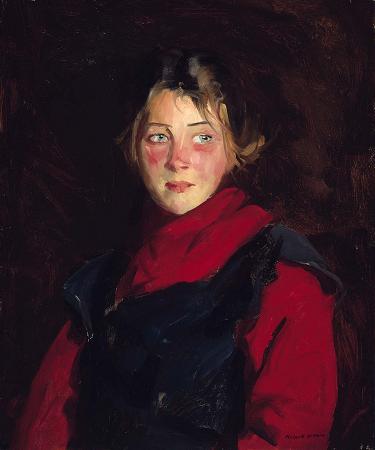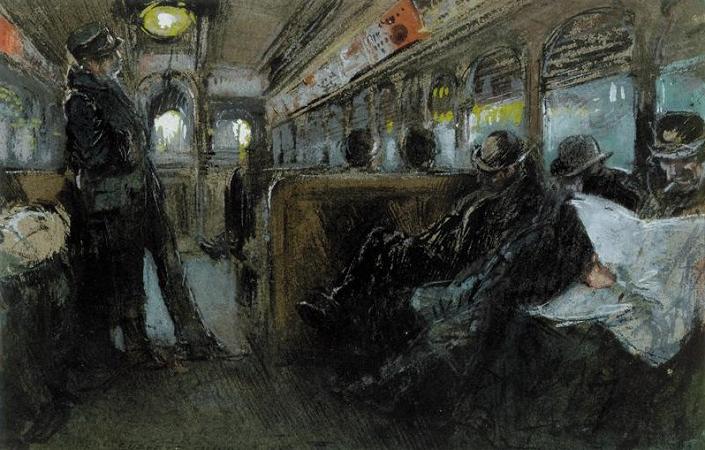Everett Shinn (1876 - 1953). Everett Shinn was an American realist painter and member of the Ashcan School. He also exhibited with the short-lived group known as The Eight, who protested the restrictive exhibition policies of the powerful, conservative National Academy of Design. He is best known for his robust paintings of urban life in New York and London, a hallmark of Ashcan art, and for his theater and residential murals and interior-design projects. His style varied considerably over the years, from gritty and realistic to decorative and rococo. Shinn was born in Woodstown, New Jersey, a large Quaker-dominated community. His parents Isaiah Conklin Shinn and Josephine Ransley Shinn were rural farmers. Their second son, he was named for the author Edward Everett Hale, of whom his father was a great fan. Shinn's ability to draw was evident from very early childhood. At age 15 he was enrolled at the Spring Garden Institute in Philadelphia, where he studied mechanical drawing. The following year he took classes at the Pennsylvania Academy of the Fine Arts, and by age 17 was working as a staff artist for the Philadelphia Press. Moving to New York City in 1897, he was soon known as one of the more talented urban realists who were chronicling in paint the energy and class divisions of modern metropolitan life. In 1898 Shinn married Florence Flossie Scovel, another artist from New Jersey; in 1912 they divorced, and in 1913 he married Corinne Baldwin, going on to have two children, Janet and David. By 1933 Shinn had divorced two more wives and was the subject of many tabloid rumors. Though he exhibited less frequently later in his life, Shinn had a well-established career by the 1920s but suffered serious financial losses during the Depression and sold very few paintings during that time. Between 1937 and his death in 1953, Shinn received several awards for his innovative paintings and participated in a number of exhibitions; he would always be associated, however, with the achievements of the Ashcan School of American art circa 1900-1920. He died of lung cancer in New York City in 1953. Shinn was reportedly a model for the talented, promiscuous artist-protagonist of Theodore Dreiser's 1915 novel The Genius. With his well-known taste for the good life, Shinn was dubbed by art historian Sam Hunter the dandy of the realists. Most art historians, as well as Shinn himself, consider his employment by the Philadelphia Press the true beginning of his art career. He was entering the field of newspaper illustration in its heyday, and he was a draughtsman of great facility. Shinn moved from paper to paper for the rest of his illustrating career, receiving a larger salary with each move. The ability to convey animated movement and the attention to detail necessary for his newspaper illustrations is reflected in Shinn's paintings and pastels, especially those treating urban themes. In 1899, he quit the newspaper business and began working for Ainslee's Magazine, a magazine that also employed his wife, who was by that time a successful illustrator and who brought in a good deal of the household income. He ultimately illustrated for a wide range of popular journals over the next twenty years, including Harper's, Vanity Fair, Life, Look, and Judge. Shinn also started displaying his paintings and pastels publicly in 1899 to mixed reactions. In 1900, he and Flossie traveled to Europe to allow him an opportunity to study other painters and to prepare to produce enough work for another exhibition. The trip influenced his art in years to come; he was especially taken with Impressionism and European art that focused on depictions of the theater. Shinn has said of his experience at the Philadelphia Press: In the Art Department of the Philadelphia Press on wobbling, ink-stained drawing boards William J. Glackens, George Luks, Everett Shinn and John Sloan went to school, a school now lamentably extincta school that trained memory and quick perception. It was during Shinn's time in Philadelphia that artists Robert Henri, John Sloan, and Joseph Laub established the Charcoal Club as an informal alternative art school. The group, which included Henri, Sloan, Shinn, and fellow illustrators and would-be painters like William Glackens and George Luks, reached a peak membership of thirty-eight and sketched nudes and critiqued of each other's work. The club, which was both ribaldly social and intellectual, is often thought of a point of origin for what became known as the Ashcan school of American art. To his friends and fellow artists, Henri urged the study of Whitman, Emerson, Zola, and Ibsen and the need for painters to forge a new style of art that spoke more to their time and experience.
more...














